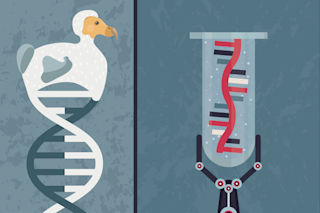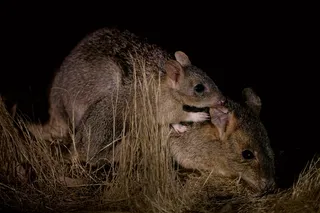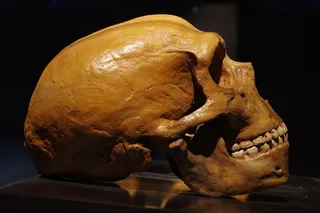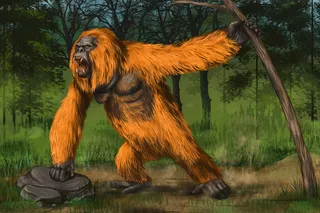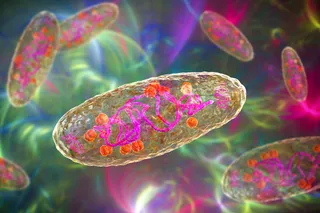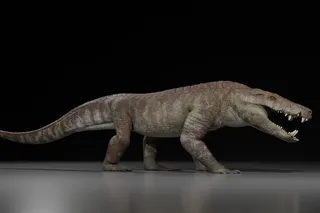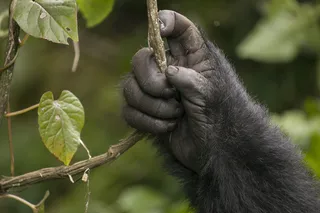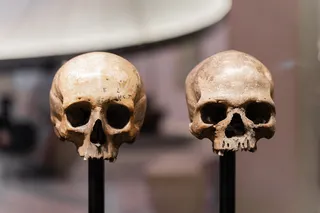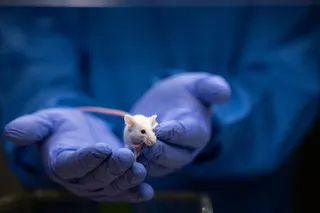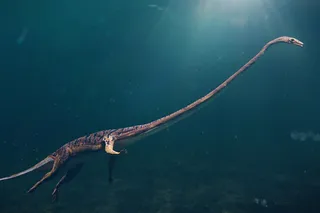Extinction has a pretty clear definition: gone forever. Or does it?
Advancements in the field of de-extinction are rapidly leading researchers to think about bringing back certain species — the passenger pigeon, Tasmanian tiger, and woolly mammoth, for example. But these projects are controversial for a number of reasons. On the extreme end is the "Jurassic Park” argument; should we really reintroduce animals that evolved and subsequently went extinct eons ago into a world completely alien to them?
Despite what the dinosaur movies depict, however, we don’t yet have the technology to bring back something from scratch (even if we did have the complete genome of an ancient species). “There are severe limitations to just how far we can take this technology today,” says Ben Novak, lead scientist of Revive & Restore, a nonprofit that harnesses biotechnologies to resurrect extinct species and save endangered ones.
In other cases, biologists are working with species that were merely extirpated from specific locales — you see, the concept of extinction isn’t always as clear-cut as it may seem. Did aurochs go extinct when humans domesticated them into modern cows, for example, or did the creatures simply change?
Florida panthers, on the other hand, never quite went extinct; but to bolster the genetic diversity of the dangerously few big cats that remained in the state, wildlife managers introduced cougars from a separate population in Texas. The panther numbers increased as a result, yet the cats that live there are now genetically different from the original panther population.
What Is De-extinction?
De-extinction involves efforts to revive or resurrect extinct species using advanced biotechnological techniques. While these projects are still in experimental stages and raise ethical concerns, they offer hope for the potential revival of species that have disappeared. Some notable scientific de-extinction projects include:
Cloning
Cloning involves using preserved genetic material, such as frozen cells, to create a genetically identical individual. However, it has its challenges, and success rates vary.
Gene Editing
Gene editing technologies like Clustered Regularly Interspaced Short Palindromic Repeats (CRISPR) are used to modify the DNA of closely related living species, with the aim of introducing extinct animal traits into the genomes of their living relatives.
Selective Breeding
Selective breeding, also known as artificial selection, is a process where humans intentionally choose and mate individuals within a species to promote specific desirable traits. Selective breeding can be applied to various species, not just those in captivity.
Captive Breeding
Captive breeding, on the other hand, refers to the practice of breeding and maintaining species in a controlled environment, typically in captivity.
Read More: Should We Bring Back Extinct Animals?
Bringing Back Extinct Animals
Explore a few examples of the species that researchers have attempted to bring back from extinction.
1. Pyrenean Ibex
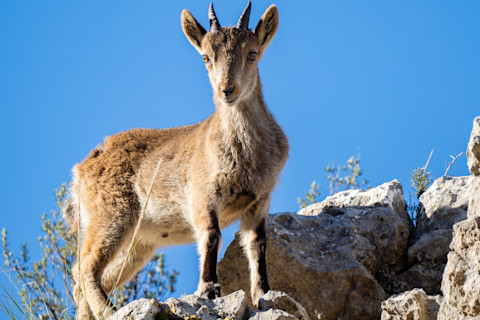
(Credit: MAV_malaga/Shutterstock)
MAV_malaga/Shutterstock
The Pyrenean ibex was a subspecies of the Iberian ibex, a wild goat with distinctive curved horns that lived in the Pyrenees Mountains of southwestern Europe. The Pyrenean ibex went extinct in 2000 when Celia, the last known member of this species, passed away. Efforts to revive this animal included a groundbreaking experiment in cloning and genetic resurrection. It is possibly the only extinct animal that has successfully been brought back to life — though it only lived for a few minutes.
In 2003, scientists used the frozen cells of the Pyrenean ibex to clone a calf. While the clone survived birth, it died a few minutes later due to lung defects, giving the subspecies of ibex the distinction of having gone extinct twice. (Novak, for the record, says that this popular statement isn’t quite true because a single female doesn’t constitute a species. “It technically was never revived,” he says.)
2. Passenger Pigeon
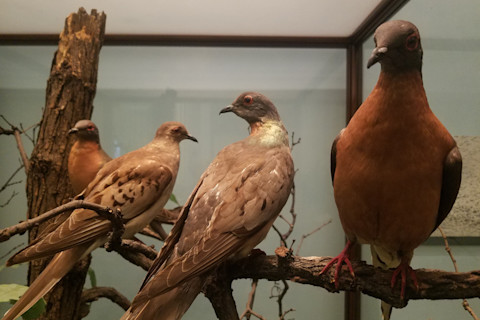
(Credit: ChicagoPhotographer/Shutterstock)
ChicagoPhotographer/Shutterstock
The passenger pigeon (Ectopistes migratorius), was a migratory bird known for forming massive flocks and its striking blue-gray plumage. Originally, they were widespread across North America, including the eastern U.S. and Canada. The passenger pigeon sadly went extinct in 1914. Efforts to revive this iconic bird have been the subject of much discussion and research.
The de-extinction of passenger pigeons is one of two projects that Revive & Restore is actively working on. The passenger pigeon program started in 2012 and involves learning how to use CRISPR to edit genes of band-tailed pigeons, a close living genetic cousin of the passenger pigeon. Experts would then introduce edited genes from the bird into the genome of the Band-tailed Pigeon, bringing back the extinct animal through genetic modification.
3. Heath Hen
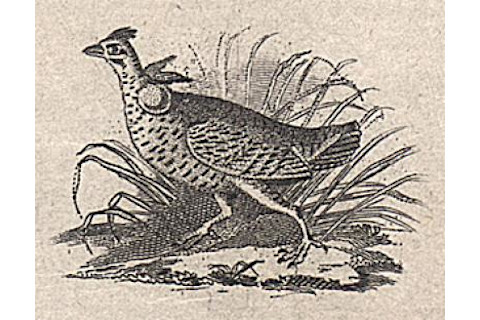
(Credit: Eric P. Newman Numismatic Education Society)
Eric P. Newman Numismatic Education Society
The heath hen (Tympanuchus cupido cupido) was a ground-dwelling bird known for its unique booming calls during the breeding season. Once abundant, this bird inhabited the heathlands and grassy areas along the Atlantic coast, particularly in the states of Massachusetts and Rhode Island. The heath hen was native to the eastern U.S. As settlers expanded into the eastern U.S., they cleared extensive areas where it thrived, contributing to its decline, eventually going extinct in 1932.
Scientists who were already working with passenger pigeons started examining the genetic material of heath hens. They explored the possibility of using a closely-related species, such as the greater prairie chicken, as a surrogate for genetic engineering.
Unfortunately, because birds lay eggs, scientists can’t rely on in vitro fertilization with them the same way they can with mammals. Researchers have made advances in growing reproductive cells in petri dishes for domestic chickens, which might help us understand more. But Novak says the recipe to keep chicken cells alive doesn’t work for the cells of wild birds. Compared to passenger pigeons, the heath hens may be a little easier to eventually restore, Novak says, as they are genetically closer to their living cousins than passenger pigeons are to theirs.
4. Woolly Mammoth
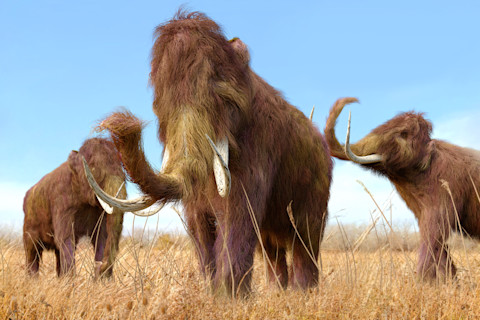
(Credit: Aunt Spray/Shutterstock)
Aunt Spray/Shutterstock
The woolly mammoth (Mammuthus primigenius) is a species of prehistoric elephant, well-known for its characteristic long, curved tusks and a shaggy coat of fur. They adapted to cold, subarctic environments and were widespread across North America, Eurasia, and even parts of North Africa.
The woolly mammoth went extinct around 10,000 years ago. This extinction coincided with the end of the last Ice Age and significant changes in climate and habitat. Scientists recovered woolly mammoth DNA from well-preserved frozen carcasses found in Siberia. Using advanced genetic editing techniques, researchers want to insert woolly mammoth genes into the DNA of their closest living relatives.
5. Tasmanian Tiger
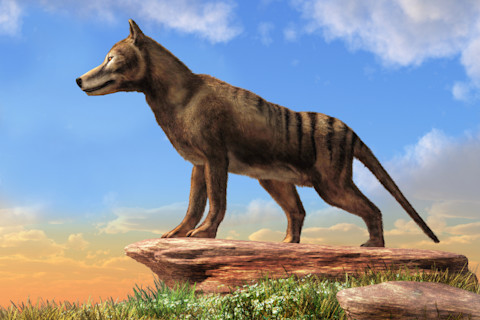
(Credit: Daniel Eskridge/Shutterstock)
Daniel Eskridge/Shutterstock
Humans captured the last known wild Tasmanian tiger, or thylacine, in 1930. Now, the University of Melbourne is heading a project to bring back the animal, one of Australia’s most storied extinct predators, and recently got a big money boost from Colossal. The project also involves gene editing — in this case, from the closest living relative of the tigers, the numbat.
6. Aurochs
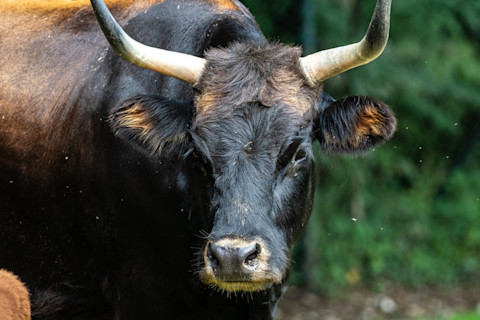
(Credit: RudiErnst/Shutterstock)
RudiErnst/Shutterstock
The auroch (Bos primigenius) was a large, wild cattle species that once roamed across Europe, Asia, and North Africa. Known for being the ancestor of modern domestic cattle, aurochs had a robust build with a strong hump over their shoulders. Their coloring varied, but they generally had dark, often black, coats. Some had distinctive white markings. Aurochs lived in a variety of environments, including forests, grasslands, and wetlands but went extinct in 1627 primarily due to overhunting and habitat loss.
Efforts to bring back the auroch are different from other methods of de-extinction. Rather than gene editing, the work to recreate the wild version of our own domesticized cows involves reversing the centuries of work that humans did to achieve a steady supply of milk and T-bone steaks. This entails selective breeding of cows to get the species back to some semblance of what their ancestors may have looked like. Since 2013, The Auerrind Project has been working on the science behind this, including radiocarbon dating, as well as learning more about natural grazing in Germany.
7. California Condor
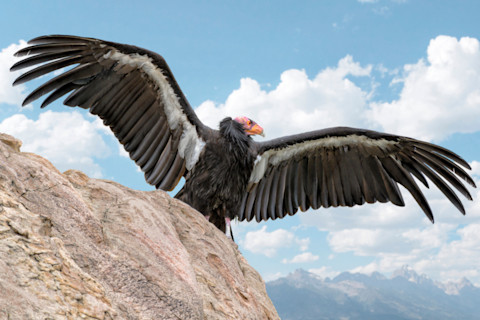
(Credit: Barbara Ash/Shutterstock)
Barbara Ash/Shutterstock
The California condor (Gymnogyps californianus) is one of the largest birds in North America with a wingspan that can exceed 9 feet from tip to tip. These magnificent birds can weigh more than 20 pounds. The male Andean condor, found in South America, is even larger than the California condor. Both species are classified as endangered. The California condor went extinct in the wild in the 1980s, when zoos took the remaining birds into captivity.
Before this, biologists had to learn how to raise these giant birds in captivity without potentially harming the few that were left. They experimented on captive raising of Andean condors — close cousins of the California species — until developing a system of raising chicks and releasing them in the wild.
Captive breeding programs for the California condors ensued, including at places like the condor sanctuary in Big Sur, California, operated by the Ventana Wildlife Society. The society releases birds every year; according to one survey, there were an estimated 334 in the wild in 2021. But challenges remain due to lead poisoning from ammunition. Recently, the Dolan blaze destroyed condor release facilities and killed several wild birds and chicks that could not escape the flames.
Read More: Can Scientists Revive Ancient Frozen Animals?
Challenges in Gene Editing and Cloning
According to Novak, gene-editing technology isn’t yet ready to make the revival of mammoths and other extinct species realistic. CRISPR can only edit a few dozen mutations per generation, while the mammoth has about one million genes that differ from Asian elephants.
One problem with reviving extinct creatures is that scientists must first obtain a complete genome. Researchers have actively been gathering mammoth DNA from museum samples — and have more than 90 percent of its genome mapped, Novak says. But most of the genetic material that organisms carry is so-called “junk DNA” that may not be completely necessary for the functioning or uniqueness of a species. The trick is finding which DNA matters.
This article was originally published on Sept. 9, 2022 and has since been updated with new information from the Discover staff.
Read More: What Animals Are Going Extinct?
Article Sources
Our writers at Discovermagazine.com use peer-reviewed studies and high-quality sources for our articles, and our editors review for scientific accuracy and editorial standards. Review the sources used below for this article:
Lead scientist of Revive & Restore. Ben Novak
Britannica. Process and techniques
University of Melbourne. Captive breeding to prevent extinction
World Wildlife Fund. Studies of Extinct Ibex Could Save Today’s Tigers
BBC News. Fresh effort to clone extinct animal
Revive & Restore. About the Heath Hen
Revive & Restore. Woolly Mammoth Revival: About the Species
Thylacine Integrated Genomic Restoration Research Lab. Our mission: Marsupial conservation and de-extinction of the thylacine
Rewilding Europe. Auerrind Project
California Department of Fish and Wildlife. California Condor
Mongabay. How Andean Condors in Peru saved the California condor from extinction (commentary)
National Park Service. World CA Condor Update – 2021 Population Status
Ventana Wildlife Society. Wildlife Sanctuaries



